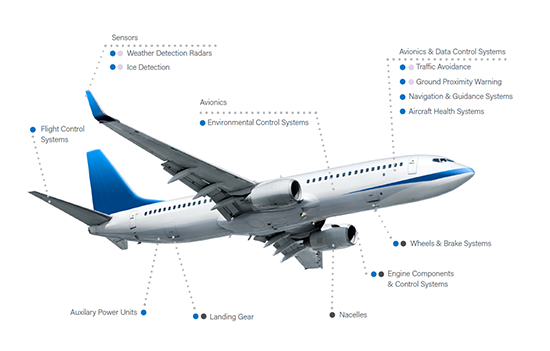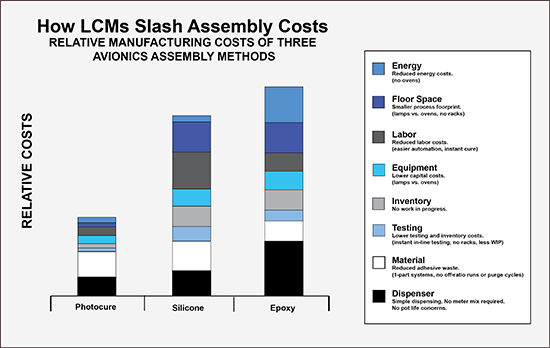How Light-Curing Technology Impacts the Design of Avionics Systems

The avionics market has a projected CAGR of 4.86% (2019-2024) with business jets, including commercial aircraft, general aviation, helicopters, and military aircraft driving a large part of this growth. The increased use of navigation, automated landing, and surveillance technology and the adoption of advanced flight management systems are some of the key areas of development. As a result, manufacturers of aircraft components are searching for ways to extend engine service life and improve the design and performance of critical systems used throughout the avionics sectors of the aerospace and defense industry.
Light-curing technology addresses these emerging industry challenges and demands for new ways to improve these systems with products that increase throughput, decrease rework and costs, boost performance, and enhance manufacturing processes. Additionally, light-curable materials can replace adhesives and coatings that contain hazardous ingredients, produce waste, and require higher amounts of energy to process. All of these attributes can help reduce product costs, life-cycle costs, and ecological impact.
What is Light-Curing Technology?
UV curing is a process in which high-intensity ultraviolet and visible light are used to initiate a photochemical reaction that generates a crosslinked network of polymers. Using light instead of heat, liquid monomers and oligomers are mixed with a small percent of photoinitiators, that when exposed to light energy, instantly cure or harden UV light-curable materials (LCMs) such as inks, coatings, and adhesives. Offering many advantages over traditional drying methods, light-curing technology increases production speed and product throughput, decreases work-in-progress and scrap, enables 100% in-line inspection, and because it is a solvent-free process, reduces environmental pollutants.

Benefits of Light-Curing Technology & LCMs
Engineers designing components for today's avionics systems may not be familiar with light-curing technology and LCMs and all the benefits they provide. They can dramatically impact a variety of areas:
Manufacturing: Shorter production process, on-demand cures, in-line assembly and inspection, one-part formulations (no mixing)
Environment: No silicones, 100% solids/solvent free, room-temperature storage
Performance: Strong bonds, environmental and chemical resistance
Design: Wide range of viscosities, flexible or rigid grades, variety of physical properties to fit applications, visible color and fluorescing capability
Green: Alternative option to solvated product offerings
Some light-curable materials used for component protection and enhancement include conformal coatings, encapsulants, maskants, thermally conductive potting materials, and structural adhesives. These products address a number of the common problems associated with avionics parts manufacturing.
- Minimize movement and shrinkage
- Address thermal management, thermal shock, and vibration
- Improve structural bonds
- Protect circuits from environmental damage
- Enhance PWB/PCA functionality and performance
- Eliminate shadow area concerns
- Solve cure confirmation issues
Typical Avionics Applications Where LCMs Can Be Utilized

Dymax Light-Curable Materials
Dymax manufactures light-curable materials that cure in seconds upon exposure to light energy and feature characteristics that not only lower manufacturing costs and increase throughput and productivity but help to diminish the impact on the environment.

Available with many innovative and patented technologies, Dymax light-curable materials turn problems like shadow areas, cure confirmation, and difficult inspection into non-issues. The products are all one-part, 100% solids and require no mixing or prep before application. Many are certified as halogen free and meet or exceed standards set forth in IEC 61249-2-21, IPC-830, and UL94. The Dymax product portfolio includes solutions for PWB/PCA assembly, structural bonding, and alignment/positioning. Features include:
- Secondary heat or moisture-cure formulations for shadow areas
- Products with excellent thermal shock, moisture, and corrosion resistance
- Blue and red fluorescing technology for easy inspection of material coverage
- Multiple viscosities for desired flow characteristics which can be tailored to specific applications
- IPC approved, MIL-I-46058C, and UL listed self-extinguishing grades
Properties & Characteristics of LCMs vs. Similar Bonding Chemistries

Available Dymax LCMs for Avionics Applications
Conformal Coatings
Conformal coatings are applied to electronic circuitry/printed circuit boards to act as protection against moisture, dust, chemicals, and temperature extremes that if uncoated (unprotected) could result in a complete failure of electronic systems. Dual-cure, fluorescing, and moisture-cure formulations are available.
Encapsulation/Wire Bonding Materials
Encapsulation and wire bonding materials provide tough, flexible protection for bare die, wire bonds, or integrated circuits (IC). Their fast cure helps reduce processing and energy costs associated with alternative technologies.
Maskants
SpeedMask® peelable electronic masks protect printed circuit board components prior to conformal coating application or wave solder and reflow processes. The fast cure allows boards to be immediately processed without the need for racking or waiting. The cured materials also leave no silicone, ionic contamination, or corrosive residues.
Potting Compounds
Potting compounds are engineered to provide tenacious adhesion to plastics and metals and superior resistance to chemicals and thermal shock. They cure tack free and reduce waste from off-ratio mixing and are free from isocyanates and heavy metals.
Structural Bonding Adhesives
Light-curable adhesives cure in seconds upon exposure to UV/Visible light, heat, or activator. They form high-strength, environmentally resistant bonds to plastic, metal, and glass. Due to their ability to bond to a wide variety of substrates, they excel at assembling dissimilar materials, something that cannot be done with traditional welding methods and other types of LCMs.
If you're manufacturing or designing components for avionics systems, Dymax has a range of products that increase manufacturing speeds, throughput, and productivity to help solve your most complex issues and positively impact your bottom line.




